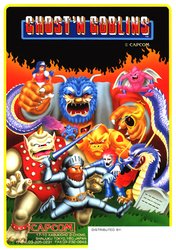The 10 Most Slaughter-Worthy Sacred Cows of Gaming
There?s one reliable law of video games: no matter how popular, influential or enduring one of them is, there?s someone out there who can?t stand it. Devoted game geeks are a preposterously high-minded bunch, perpetually finding joy in pointing out how Halo, Super Mario Bros. 3, Vagrant Story, or any other game with more than three fans is terrible and overrated and probably carcinogenic.
Yet there are rare cases of games rising in fan esteem without drawing their due backlashes. You might mistake them for truly excellent titles, but the truth is that, most of the time, these purported classics are mediocrities that just haven?t been run through the proper gauntlet of hateful criticism. Good thing we specialize in that.
10. Splatterhouse (Arcade, TurboGrafx-16)
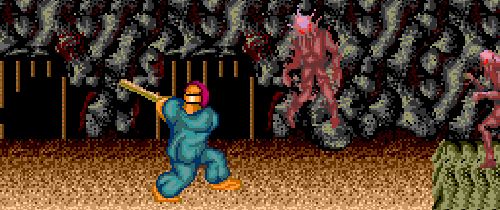
Namco?s Splatterhouse was so superficially fine-tuned to the tastes of 10-year-old American kids that it?s a wonder it didn?t land a movie, a syndicated cartoon, and a Hi-C flavor, all prominently featuring a hulked-out killing machine in a Jason Voorhees mask. And, just to keep things safe for parents, he?s the good guy.
The problem lies in Splatterhouse?s design, which pares down the furious pace of arcade action games to focus on dealing out gruesome death with slower, more dramatic flair. The game shows some variety in its challenges, even whipping out a Poltergeist tribute for a boss battle, but it?s really just short, simple and not worth revisiting since that fifth-grade sleepover.
Namco gave Splatterhouse two sequels and a cutesy, only-in-Japan 8-bit spin-off, but their enthusiasm fell with each release. By the third time Non-Jason was rescuing his girlfriend/wife and fighting numerous shambling tributes to horror movies, kids had moved on to Mortal Kombat and never looked back. Splatterhouse was recently revived for a modern remake, completely with a roided-out hero and rampant gore. It might well improve on the original, but that wouldn?t be too hard.
9. Q*Bert (Arcade, etc.)
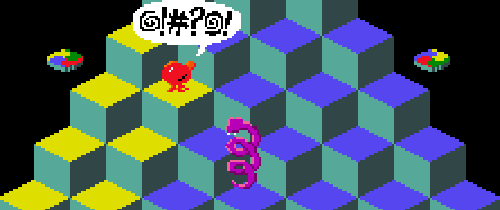
Arcade hits of the Atari era are often protected from criticism by a thick, blubbery coat of fond memories. Just about every game idea was an innovation until 1984 or so, and there?s no shortage of older fans who?ll confuse historic relevance with quality. Still, sensible history may judge Q*bert as an also-ran, one of the first by-products of Pac-Man?s cuddly success. It was also the first time arcade goers had to guide an armless, huge-nosed orange Muppet around a pyramid of cubes.
It was easy for arcade goers to accept Q*bert?s awkward controls, which used diagonal directions and didn?t let Q*bert himself jump horizontally. And they even liked the overall uniformity of the game?s levels, in which only the enemies really change. Beneath it all, though, there?s a clumsy pace that can?t be fixed by the merchandisable characters or the way the arcade cabinet lets out an endearing thump whenever Q*bert falls to his death.
Q*bert was a hit more on the strength of its cast than anything. They showed up on Saturday morning TV, in toy stores, and across T-shirt fronts. The public liked Q*bert and his needless asterisk, and the giant walking nasal cavity is appealing even today. It?s the game that doesn?t hold up.
8. Castlevania (NES)

Konami?s Castlevania wasn?t the first side-scrolling action game on the NES. It was, however, the first one that dug into the vast Americanized history of monster lore and put Dracula, the Grim Reaper, Frankenstein?s folly, Medusa and a giant bat in the same game. Castlevania even helped established many new trends for its genre: life meters, special weapons, and, uh, breakable walks. But Castlevania isn?t a particularly good game, and perhaps it never was. Simon Belmont, the whip-cracking hero in furred shorts, walks slowly. He jumps slowly. And he dies over and over in situations that a reasonably nimble game character would easily survive. That?s perhaps why Castlevania?s levels are so frustrating and sluggishly paced, notable only for their sense of 8-bit gothic atmosphere.
This stiff, unintuitive approach dogged the series for years, afflicting GameBoy games, two NES sequels, and a Super NES remake of the original. It wasn?t until 1993 and the TurboDuo?s Dracula X: The Rondo of Blood that the series bothered improving itself. Granted, the Castlevania formula was patched up way back in 1989, when the Ninja Gaiden series stole it and made it faster, tighter and much more fun. Castlevania was just throwing that formula away, anyway.
The long-term Castlevania faithful try to excuse the dreadful structure and muddled controls by claiming that it?s supposed to be slow-paced, as though a boring game is excusable so long as it?s intentional. They also complain about the modern Metroid-like maze runs that make up much of Castlevania nowadays, as though things were better when the games were grueling, one-track pabulum.
7. Pac-Man (Arcade, everything else)

It?s impossible to hate Pac-Man as the smiling anthropomorphic sphere with old-fashioned Disney eyes, or as the armless blob who had to be renamed from ?Puck-Man? for reasons obvious to anyone who?s ever vandalized an arcade, or even as the breakthrough icon that saved arcade games from an flood of dull monochrome shooters.
When it comes to Pac-Man the game, it?s a little harder to find that shared cultural joy. True, the combination of a maze, a pack of ghosts, and an endearing pellet-gobbling sound enraptured many arcade goers in the early ?80s, but there?s no question that Pac-Man?s a little outdated, even by its own standards. It?s aged better than some other maze-driven games of its day, but there?s one problem: the maze never really changes. The ghosts get faster, the bonus-point fruit gets more elaborate, but the level?s really the same thing over and over.
In fact, Pac-Man was outdone by Ms. Pac-Man and its varying level designs, and further so by its 1994 sequel, the completely different and completely underrated Pac-Man 2: The New Adventures. Not that it matters, as Pac-Man remains a piece of modern culture, guaranteed a spot in game history and whatever arcades haven?t yet closed down. Go ahead and play. If you?re lucky, you?ll die before the game gets boring.
6. Gradius (Arcade, NES, etc.)
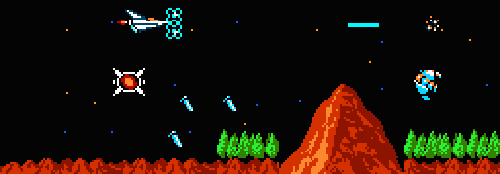
Since its 1986 arrival, Gradius has been the space-shooter cousin of Castlevania, revered more for being first than being enjoyable or impressively programmed. It deserves credit for setting some standards; without it, we wouldn?t have a world of interchangeable side-view shooters where a humble, triangular starfighter nabs power-ups and blasts some intergalactic alien force.
And, like Castlevania, Gradius is a crawling bore, primarily because of a lousy power-up system. The Vic Viper ship is a slow, under-armed death trap, reliant entirely on power-ups to speed it up or grant better weapons. The problem? Not only are power-ups infrequently doled out, but the Viper loses almost all of them when it?s destroyed, thus sending the player back to an earlier point in the level. With its inflexible design and refusal to improve, Gradius spawned a subculture of shooters where you?re completely screwed if you die once. This, in turn, spawned a subculture of shooter fans who actually force themselves to enjoy memorizing every inch of a dull game.
Gradius also shares Castlevania?s long-overdue upswing. Konami?s Lifeforce spin-off marginally improved on Gradius in the ?80s, but it wasn?t until 2004?s that an excellent game arrived in the form of Gradius V.
—-
5. Ys Book I and II (TurboGrafx-16, etc.)

The TurboGrafx-16 and its CD attachment had a brief, ugly life in the U.S., where the system was constantly bullied by the Sega Genesis and Super NES. Yet for one brilliant moment around Christmas of 1989, a TurboGrafx owner could pop in Ys Book I and II and bask in the envy overflowing from everyone in the room.
Most CD-based games of the day were grainy, slapdash collections of live actors stumbling through cheap studio sets, which made the Ys collection that much more impressive. It looked like a typical action-RPG, but the lush soundtrack and uncommonly decent voice acting awed crowds who were used to the bleeps of Super Mario Bros., while the animated scenes were stunning in a time when all anime was inherently exotic. Even the story, which found a silent wanderer named Adol in a land of buried kingdoms and wide-eyed girls, was a striking leap from the plot-free RPGs of the ?80s. Things went south if those TurboGrafx owners let their friends actually play the game. Ys used a bizarre battle system: instead of swinging a sword, Adol simply runs into enemies and either loses energy or damages them. It?s a strange simplification of basic RPG battles, and it proves awkward and repetitive as the game wears own. Eventually, players settle for ramming foes from just the right angle.
Time has stripped the Ys games of much of their appeal. The music is still impressive, but the story is little more than generic anime-fantasy schlock, and the unorthodox combat is frustratingly limited. You?ll never be the game you were in 1989, Ys Book I and II, but at least you shut up someone?s Genesis-owning friends for a little while.
4. Ghosts ?n Goblins (Arcade, NES, etc.)
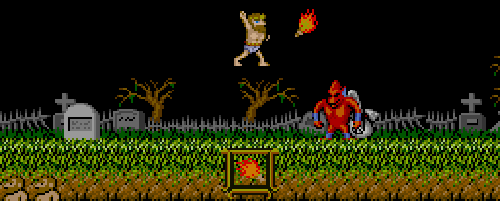
There?s a certain type of gamer who loves a steep, completely unreasonable challenge. This type loves dungeon-exploring RPGs that have to dole out obscene punishments to be remotely interesting. This type adores beating shooters on one life for no valid reason. And this type invariably loves Capcom?s Ghosts ?n Goblins series. Why? Because Ghosts ?n Goblins and its sequel, Ghouls ?n Ghosts, are the game equivalents of nipple torture toys. The armor-clad Arthur can take two hits before dying, and it?s all too easy to take them both by the time you?ve reached, say, the red flying devil ten seconds into Ghosts ?n Goblins. From that point on, it?s steep test of not only the player?s reflexes, but of how many ridiculous cheap deaths he or she will tolerate before moving on to another game. Perhaps the most insulting part comes after the last boss is defeated and players learn that they?ve got to go through the game again to get any sort of ending.
The worst thing about the games is that they?re well-designed: the levels constantly throw out new enemies, and the control?s as spot-on as it in other old-school Capcom games. It?s just not all that fun. And don?t let the nutcases tell you otherwise.
3. Skies of Arcadia (Sega Dreamcast)
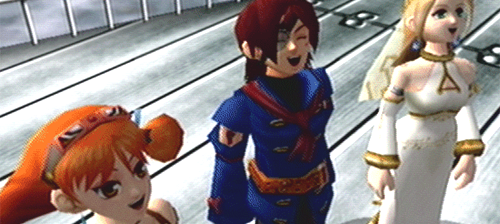
Few RPGs escape a stern critical reception. For an example, look to whatever Final Fantasy games came out this week; each has likely been fiercely despised in its own fan community. Sega?s Skies of Arcadia sidestepped a lot of its justly deserved excoriation by appealing to the most desperate of gamers.
Arcadia?s fans point to its lighthearted tone, its sense of exploration, and other suspiciously vague praises that don?t really mean anything. It all occludes the fact that there?s no defensible reason for anyone liking Skies of Arcadia, beyond the player being eight years old in body or intellect. The game spins a painfully gee-whiz tale of sky pirates, an evil empire, an ancient civilization, and a land of floating continents. In other words, it?s a turdpile of lazy ideas and characters with one personality trait apiece. Most of these ideas were filched from the already mediocre The Granstream Saga, and all of them are trite to anyone who?s played a single decent Japanese RPG or watched more than two minutes? worth of Japanese cartoons. This is to say nothing of Arcadia?s woefully misguided structure. The game offers wide-open vistas of hovering lands to navigate in your airship, but in order to actually go anywhere, you?re forced to fight one meaningless random battle after another. Never mind that you?re sailing through the skies in a ship that, by even the thinnest logic, should be able to bypass conflict.
Skies of Arcadia wasn?t remotely interesting, but it was lucky. In 2000, Dreamcast owners and the Sega faithful were desperate for an RPG, and when it was revealed that some of Arcadia?s staff worked on the cherished Phantasy Star games, many refused to believe that Sega?s next major RPG could go astray, no matter how many inane plot points or tedious battles slapped them in the face.
Skies of Arcadia and its empty-eyed heroes also arrived after the angst-tainted melodrama of Final Fantasy VIII was starting to seep into other RPGs. Tired of pretentious and serious games, some flocked to Arcadia and, in their delusion, ignored Threads of Fate and other puffball RPGs that were, well, genuinely good. In the end, Skies of Arcadia proved why Japanese RPG creators go for bathetic teenage frustration so often: it?s better than nothing at all.
2. Dragon Quest (NES, etc.)

There are some who refuse to hear any criticism of the Dragon Quest series. After all, it?s a monstrous success in Japan! Everyone plays it there, even the people who don?t play videogames! Kids cut classes and office drones skip work to line up for the newest game! It invented Japanese RPGs! They play the Dragon Quest theme at schools! There?s nothing whatsoever wrong with Dragon Quest so why don?t you just shut the hell up about it?
Well, there?s nothing wrong aside from the fact that the games have used the same tired battle interface for the past 22 years. That?s kind of a problem. It?s not a pressing issue in Japanese pop culture, which has readily bought minor alterations of the same music, cartoons, movies, and TV shows for decades on end. Nor does it seem to bother Western RPG fans, many of whom are unreasonably nostalgic for the same grinding RPG battles they tolerated as children.
It is, however, a concern for anyone who demands RPG play with more than the same routine menu-driven commands and the horribly outdated concept of randomly occurring battles. Even with its gorgeous visuals and capable localization, Dragon Quest VIII is really no different from the game that started it all back in 1986. Remember how Earthbound showed enemies before you encountered them and let you bypass combat if you outmatched them? Remember how it did that back in 1995? Well, Dragon Quest will have none of those supposed ?improvements.? There?s a legacy to uphold here.
1. Kid Icarus (NES)
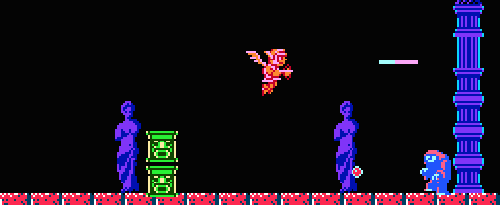
The first few years of the Nintendo Entertainment System were lean, as companies scrambled to release whatever they could for the suddenly successful console. Pity the poor boy who ended up with Deadly Towers after mistaking it for Zelda, or the girl who picked out Athena because it was the only NES title with a heroine on the box. In this wide-open playing field, even an average game could succeed if it had an appealing concept or the backing of a major publisher. And Kid Icarus had both. Aside from Metroid, The Legend of Zelda, and Super Mario Bros., it was one of the few pieces of Nintendo?s first-party lineup that wasn?t a blunt novelty or a glorified mini-game. Kid Icarus has personality, with its squat, winged hero flitting up through stages, bargaining with merchants, and even getting turned into an eggplant.
It was easy for the still-forming Nintendo generation to like Kid Icarus, in spite of its repetitive jumping, simple stages, awkward controls and numerous unfair ways to die. Kid Icarus and the Eggplant Wizard even had a spot on that monument to Nintendo hubris, Captain N: The Game Master.
But Kid Icarus couldn?t last. After a slightly better GameBoy game, he dropped from view, not to resurface until Super Smash Bros. Brawl. This inspired many to clamor for another full-fledged Kid Icarus, and it?s perhaps a noble aim. There?s the seed of a great game in the original, and a remake could finally shows its fans just how flawed the Kid Icarus of 1987 was.

